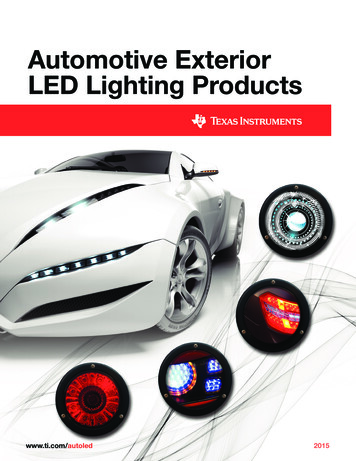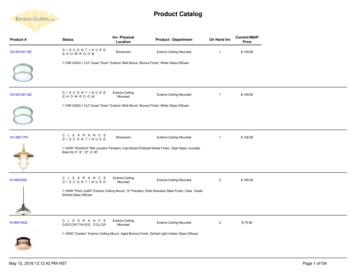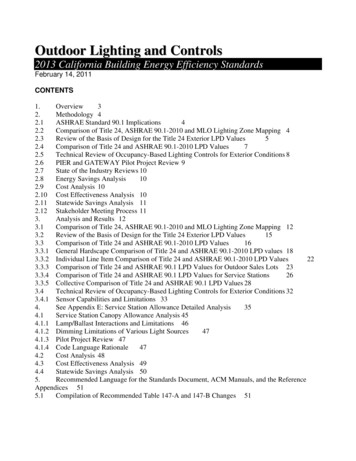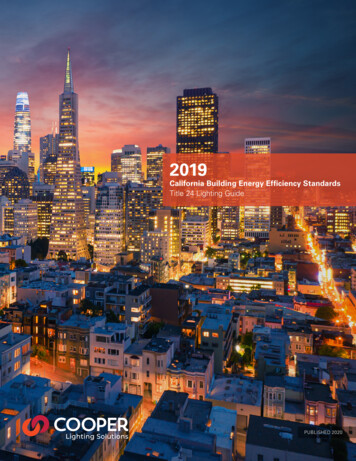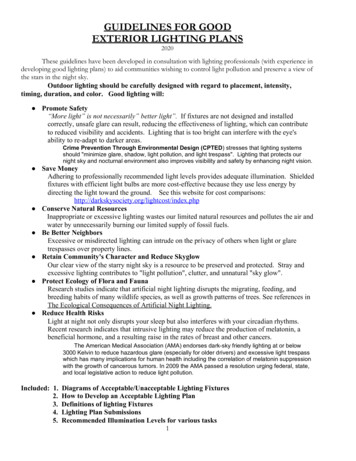
Transcription
GUIDELINES FOR GOODEXTERIOR LIGHTING PLANS2020These guidelines have been developed in consultation with lighting professionals (with experience indeveloping good lighting plans) to aid communities wishing to control light pollution and preserve a view ofthe stars in the night sky.Outdoor lighting should be carefully designed with regard to placement, intensity,timing, duration, and color. Good lighting will: Promote Safety“More light” is not necessarily” better light”. If fixtures are not designed and installedcorrectly, unsafe glare can result, reducing the effectiveness of lighting, which can contributeto reduced visibility and accidents. Lighting that is too bright can interfere with the eye'sability to re-adapt to darker areas.Crime Prevention Through Environmental Design (CPTED ) stresses that lighting systemsshould "minimize glare, shadow, light pollution, and light trespass". Lighting that protects ournight sky and nocturnal environment also improves visibility and safety by enhancing night vision. Save MoneyAdhering to professionally recommended light levels provides adequate illumination. Shieldedfixtures with efficient light bulbs are more cost-effective because they use less energy bydirecting the light toward the ground. See this website for cost dex.php Conserve Natural ResourcesInappropriate or excessive lighting wastes our limited natural resources and pollutes the air andwater by unnecessarily burning our limited supply of fossil fuels. Be Better NeighborsExcessive or misdirected lighting can intrude on the privacy of others when light or glaretrespasses over property lines. Retain Community's Character and Reduce SkyglowOur clear view of the starry night sky is a resource to be preserved and protected. Stray andexcessive lighting contributes to "light pollution", clutter, and unnatural "sky glow". Protect Ecology of Flora and FaunaResearch studies indicate that artificial night lighting disrupts the migrating, feeding, andbreeding habits of many wildlife species, as well as growth patterns of trees. See references inThe Ecological Consequences of Artificial Night Lighting. Reduce Health RisksLight at night not only disrupts your sleep but also interferes with your circadian rhythms.Recent research indicates that intrusive lighting may reduce the production of melatonin, abeneficial hormone, and a resulting raise in the rates of breast and other cancers.The American Medical Association (AMA) endorses dark-sky friendly lighting at or below3000 Kelvin to reduce hazardous glare (especially for older drivers) and excessive light trespasswhich has many implications for human health including the correlation of melatonin suppressionwith the growth of cancerous tumors. In 2009 the AMA passed a resolution urging federal, state,and local legislative action to reduce light pollution.Included: 1.2.3.4.5.Diagrams of Acceptable/Unacceptable Lighting FixturesHow to Develop an Acceptable Lighting PlanDefinitions of lighting FixturesLighting Plan SubmissionsRecommended Illumination Levels for various tasks1
Fully Shielded Fixtures (Zero Uplight)UNSHIELDED FIXTURESDiagrams courtesy of Bob CrelinAsk your local electrical suppliers for IES designated "Zero Uplight" or “Fully Shielded” lightfixtures. Once you have selected fixtures which are compatible with your architecture andcommunity, contact the manufacturer’s representative to see a sample of the fixture(s), the“cut sheet” to show your client and municipal officials, and to ask for a free lighting plan. Ifyou have a CAD file, the plan can be easily provided in a short period of time.***Definition of “Fully Shielded/Zero Uplight”: A light fixture with an opaque shield above thelamp (bulb), so that, as designed and installed, the light fixture projects all its light below thehorizontal plane through the lowest light emitting part of the fixture.Most lighting manufacturers have Application Departments which will execute free lighting plansto meet local lighting codes if they are provided these Guidelines.2
How to Develop an Acceptable Lighting PlanDeliver these requirements to a manufacturers’ representative or send to the manufacturersapplications department with a site plan (CAD file) shading in the areas to be illuminated and thehours of anticipated use for each area. Manufacturers will provide a lighting plan at no costs onceyou and your client have chosen the style of fixture that meets your aesthetic design.1. Identify where as well as when lighting is needed. Minimize lighting to the extent necessaryto meet safety purposes . Plans should define the areas for which illumination is needed for safe pedestrianpassage and indicated when those areas are expected to be used. Itemize each area (e.g. parking lot,doorways, walkways, signage, foliage) with the anticipated hours of use. Commercial outdoor lighting shouldbe used for safe pedestrian passage and property identification, and lit during active business hours and shutoff afterward. Use a highlighter on a site plan for those areas to be lit to professional recommendations.2. Direct light downward by choosing the correct type of light fixtures . (See Appendix 3).Specify IES (Illuminating Engineering Society) “Zero Uplight” or “fully shielded” fixtures, so that no light isemitted above the lowest light emitting part of the fixture. Top mounted sign lighting is recommended with"RLM" (dish) type shields, and aimed so that the light falls entirely on the sign and positioned so that thelight source (bulb) is not visible from any point off the property or into the roadway to reduce glare. Foreach one square foot of sign, usually no more than 200 lumens is necessary for good visibility.3. Select the correct light source. Compact fluorescent (2700K or less) or High Pressure Sodiumis recommended unless the light is motion sensor activated, in which case LED, incandescent, or the instantstart compact fluorescent bulbs can be used. Metal Halide (due to its higher costs, energy use, impact onthe environment, and greater contribution to "sky glow") is discouraged, as well as LED light sources ratedover 2300 Kelvin. Outdated Mercury Vapor bulbs are prohibited. Limit the use of LEDs to fixtures thatare motion sensor activated and with less than 2300 Kelvin; or in 1800 Kelvin fixtures that are not operateddusk to dawn.4. Utilize "shut off" controls such as sensors, timers, motion detectors . Automatic controlsturn off lights (or sections of lights) when not needed. Interior and exterior lights should be extinguishedno later than one half hour after the close of business. Additional motion sensor activated lighting can beused for emergency access. Avoid "dusk-to-dawn" sensors without a middle-of-night shut off control.Lights alone will not serve to "protect" property and are a poor "security" device. Examine other means ofprotecting property to discourage criminal activity. Let your local police know that you have a “lights out”policy so that they can investigate if they see lights “on” after hours.5. Limit the height of fixtures . Locate fixtures no closer to the property line than four times themounting height of the fixture, and not to exceed the height of adjacent structures. (Exceptions may bemade for larger parking areas, commercial zones adjacent to highways, or for fixtures with greater cut offshielding behind the pole mount in commercial zones.)6. Limit light crossing property lines, i.e. “light trespass” . Limit spill light across the propertylines. Light levels at the property line should not exceed 0.1 footcandles (fc) adjacent to business properties,and 0.05 fc (the brightest moonlight is 0.01 fc) at residential property boundaries. Utility leased floodlightfixtures mounted on public utility poles in the public right-of-way or on property lines shall not be used forprivate property due to excessive light trespass “spill light”.7. Use the correct amount of light . Light levels and uniformity ratios should not exceedrecommended values, per IESNA RP-33 or 20. (See Appendix 5, Recommended Illumination Levels for3
various tasks). "Lumen cap" recommendations for areas to be illuminated should not exceed: commercialproperties in non-urban commercial zones 25,000 lumens per acre; for projects in residential and LBOzones 10,000 lumens per acre. For residential properties: for suburban: 50,000 lumens per acre cap, andin urban areas: 100,000.8. Ask for Assistance Your Planning Department and local lighting sales representatives can assistyou in obtaining the necessary information for good lighting. For large projects over 15,000 lumens:greater energy conservation and control of light pollution, light trespass and glare, may be achieved with thehelp of a professional lighting designer with "dark sky" lighting plan experience.9. A post installation inspection should be conducted to check for compliance with a light meteragainst the approved lighting plan. Substitutions by electricians and contractors are common and should notbe accepted.10. Design interior lighting so that it does not illuminate or project glare to the outdoors.Provide interior lighting photometrics for the building’s perimeter areas, demonstrating that the interiorlighting falls substantially within the building and not through the windows. When glass or windows on acommercial use property face a public right of way or a residential property, a lighting plan shall besubmitted that demonstrates that all interior light fixtures shall be located, aimed, or shielded so that thelight source and all parts of the fixture which transmit light shall not be visible at the property line or intothe right of way. Shield glare from bare bulbs. After closing, interior lighting needs to be extinguished bythe use of shut off timers. Avoid “wall washing” (upwardly directed lighting to illuminate the building).11. Free Lighting plans can be provided by a lighting manufacturers’ Applications Departments.Select a manufacturer based on the type and range of fixtures. Submit criteria (attached) along with a siteplan (electronic preferred) that has been marked with a highlighter on those areas that are to be lit forpedestrian safety and where pedestrians and cars are in conflict. Separate areas that are to be lit at differenttimes so that they can be placed on separate circuits. Specify motion sensors to be used on all areas anddoorways that are not active during nighttime hours.12. Flag Lighting can be accomplished with a top mounted fixture with automated shutoffs formiddle of the night energy conservation. Flags are not required to be lit.4
Definition of Acceptable Fixtures:"Fully Shielded" (Zero Uplight) and RLM shields."Fully Shielded" or “Zero Uplight” fixtures are independently certified by themanufacturers, and do not allow light to be emitted above the lowest light emitting part of thefixture. Manufacturers provide cutoff designations for their fixtures to indicate the percentage oflight that is emitted in various directions. Up, Back, Forward in High, Medium, Low angles. If the manufacturer is unable to provide the cut off characteristics for a fixture (also called a"luminaire"), the following definition needs to be met, which can sometimes be determinedby a visual inspection of the fixture or a cut sheet (it is best to have the photometric data):"Fully Shielded": a fixture constructed and installed in such a manner that all lightemitted by it, either directly from the lamp (bulb) or a diffusing element, or indirectlyby reflection or refraction from any part of the fixture, is projected below thehorizontal. This can be determined by a "field test" or a visual assessment of anoperating sample or by examining a manufacturer’s supplied cut sheet photograph. Manufacturers and their representatives can provide photographs of light fixtures as "cutsheets" as well as literature confirming the independently tested "cut off" characteristics oftheir products. These IES files may be assessed for compliance in a computer program:http://www.3dop.com/index1.html Photometric layouts for various heights, light sources, and wattages are also available as"IES" files upon request or through manufacturers' websites. Fixtures must be installed properly, so that the bottom of the fixture is level with theground. Exceptions are often given for sign lighting which requires vertical lighting,provided that the light source (bulb) is shielded from view from off the property or into aroadway. Sign lighting shall be mounted above the sign, lamped so that the footcandle maximum onthe face of the sign does not exceed 2 footcandles (fc).Example of an"RLM" sign lighting shield:5
Lighting Plan SubmissionsThe following information needs to be provided to your municipality's review board which will enable themto evaluate the Site Plan for proper exterior lighting:The Lighting Plan should be depicted on a site plan, indicating the location of each current andproposed outdoor lighting fixture with projected hours of use. This plan will need to be stamped andcertified by a licensed professional, such as an architect or engineer. Many lighting manufacturers canprovide free photometric layouts on prepared site plans, to conform to your local requirements.(1)(2)The lighting plan should include the following information for all proposed and existing: Type and number of luminaire equipment (fixtures), including the "cut off characteristics",indicating manufacturer and model number(s). Lamp source type (bulb type, i.e. high pressure sodium), lumen output, and wattage. Mounting height with distance noted to the nearest property line for each luminaire. Types of timing devices used to control the hours set for illumination, as well as the proposedhours when each fixture will be operated. Total Lumens for each fixture, and total square footage of areas to be illuminated. For all plans of more than three fixtures: A Calculation Summary indicating footcandle levels onthe lighting plan, noting the maximum, average, and minimum, as well as the uniformity ratio ofmaximum to minimum and average to minimum levels* to avoid “hot” spots of light.(3)Lighting manufacturer-supplied specifications ("cut sheets") that include photographs of thefixtures; and for fixtures that are rated to exceed 2000 lumens, submit the certified BUG (ZeroUp Light) designation for the fixture or fixtures.(4)For a lighting design with multiple fixtures (e.g. parking lots and walkways) a Lighting Plan shallinclude light levels in footcandles on the ground at the designated mounting heights for theproposed fixtures. Maximum illuminance levels should be expressed in footcandlemeasurements on a grid of the site showing footcandle readings in five foot grids. The grid shallinclude light contributions from all sources (i.e. pole mounted, wall mounted, sign, and streetlights.) Show footcandle measurements five feet beyond the property lines.(5)If requested by the reviewing agency, a statement from a lighting design professional that a plan,other than that required is needed to meet the intent of these standards.(6)An environmental impact statement may be required as to the impact of the exterior lightingproposed on adjacent preserves or waterways to include flora, fauna, and the night sky.Location of species sensitive to light at night or the proximity to nature preserves orastronomical observatories or "Dark Sky Parks", needs to be indicated.(7)On the Approved Plan it should be noted that no substitutions, additions, or changes may bemade without prior approval by the governing authority; and that all lighting not on the planshall be removed and no additional lighting shall be installed without prior approvals.6
Recommended Illumination Levels for various tasks*I. Table of Limits of Illumination , measured in footcandles (fc) at ground level unless noted:Task Area1. Active Building EntranceApproach2. Gas Station Approach3. Gas Station Pump Area4. Gas Station Service Area5. Sidewalks6. Surface of signsAvg.2.0 fc0.2 fc0.2 fcorNot to exceed:5 fc2 fcavg: 5 fcavg. 3 fc5 fc2 fcII. Average/Minimum/Uniformity Ratio Limits for Parking Lots (RP 20 – 14) LZ 1/2MinimumAverage/Minimum Maximum/Minimum1. Small Commercial lots0.5 fc4:0115:012. Public larger lots1.0 fc4:0115.01OR:III. If illuminance grid lighting plans cannot be reviewed or if fixtures do not provide IES designationsand photometrics and the light sources (bulbs) are rated less than 2000 lumens, use these guidelines:1. Pole position shall be no greater in height than four times the distance to the propertyline.2. Maximum Lumen Levels for different fixture heights:Mounting Height (Feet)Recommended Lumen Maximums6500 - 1000 lumens8600 - 1,600 lumens101,000 - 2,000 lumens121,600 - 2,400 lumensFOOTCANDLE : ("FC") – Is the basic unit of illuminance (the amount of light falling on a surface).Footcandle measurement is taken with a hand held light meter. One footcandle is equivalent to theilluminance produced on one square foot of surface area by a source of one candle at a distance of one foot.Horizontal footcandles measure the illumination striking a horizontal plane. Footcandle values can bemeasured directly with certain handheld incident light meters.LUMEN – A unit used to measure the actual amount of light that is produced by a bulb.The lumen quantifies the amount of light energy produced by a lamp at the lamp, not by the energyinput, which is indicated by the "wattage". For example, a 75-watt incandescent lamp can produce 1000lumens while a 70-watt high-pressure sodium lamp produces 6000 lumens. Lumen output is listed by themanufacturer on the packaging.* IES, Recommended Practices, (RP-33-99): Lighting for Exterior Environments; and (RP-20):Parking Lots . The Illuminating Engineering Society of North America (IES or IESNA), is an organizationthat establishes updated recommendations, standards, and illumination guidelines for the lighting industry.http://www.iesna.org7
10. Design interior lighting so that it does not illuminate or project glare to the outdoors. Provide interior lighting photometrics for the building’s perimeter areas, demonstrating that the interior lighting falls substantially within
